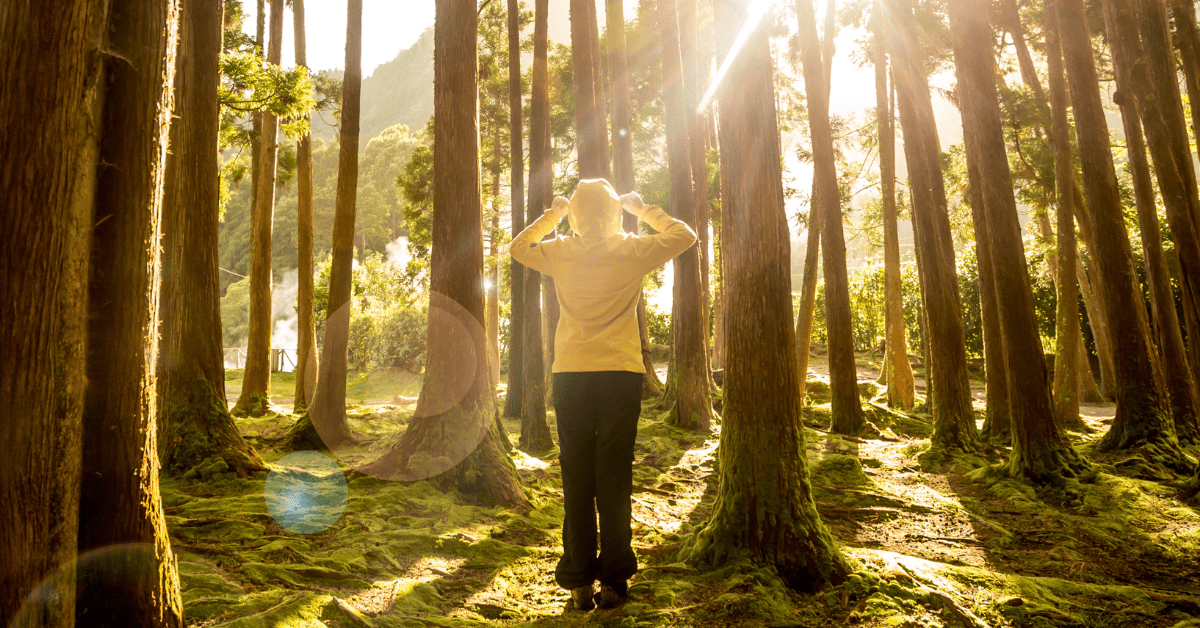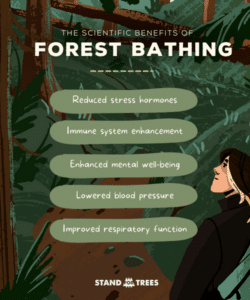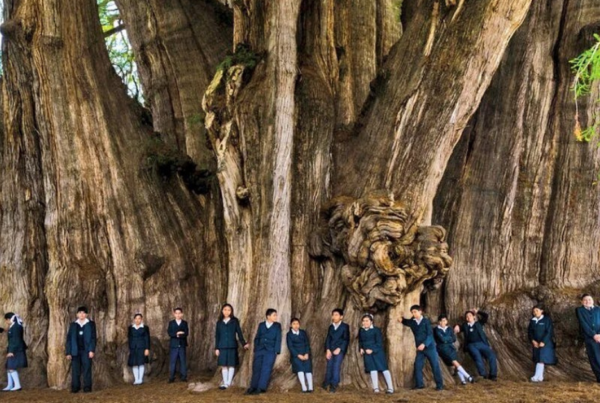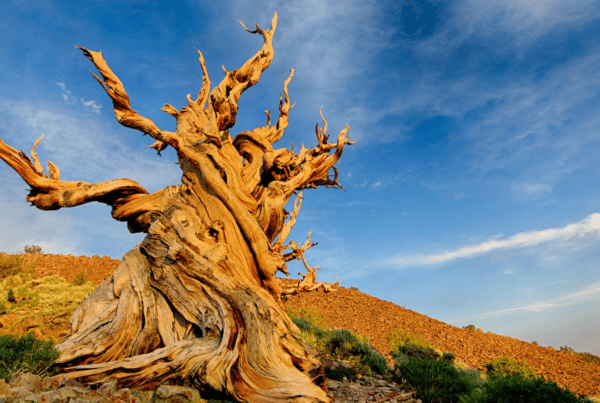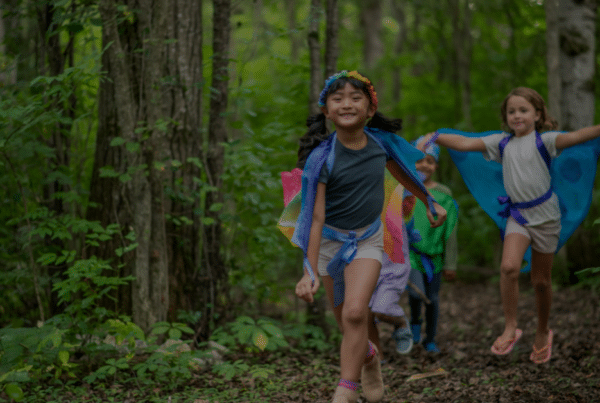The Key to Mindful Travel? Step Into a Forest’s Calming Embrace.
Visit these five destinations to practice the art of forest bathing – plus learn how you can keep these forests standing.
You likely know how good it feels to be in nature. We all do. In fact, for centuries, humanity has recognized the profound sense of well-being that envelops us when we immerse ourselves in nature. The forest’s whispering leaves, the earthy scent of trees, and the gentle caress of sunlight through the branches have an almost magical way of easing our stress, granting us clarity of thought, and inviting us to relax. Nature’s embrace is a source of comfort, replenishing our energy, revitalizing our spirits, and refreshing our outlook on life. But what is the science behind this enchanting feeling, and how can we practice this in our lives for a potentially healthier, happier you?
In a world that is perpetually on the move, where digital screens dominate our lives, and the chaotic pace of urban existence becomes overwhelming, more and more people are turning to “forest bathing.” Forest bathing, a practice conceived in Japan, offers a transformative way to reconnect with nature and rejuvenate the mind, body, and soul. In this blog, we’ll take an in-depth look at the concept of forest bathing, explore its incredible benefits, guide you on where to take part in this therapeutic practice, and explain how you can contribute to the conservation of these forests. In short, keep reading if you want to learn more about forest bathing – what it is and where to experience it.
What is Forest Bathing?
Forest bathing is a practice rooted in the Japanese tradition of “Shinrin-yoku” (pronounced as “sheen-rin-yoh-koo”), which translates to “taking in the forest atmosphere” or, in short, “forest bathing.” It is a wander in the woods where we use all our senses. For instance, during a guided forest bathing session, you may tune in to the symphony of forest sounds, allowing the rustling leaves and the songs of birds to envelop your awareness. Alternatively, you might pick up a stone and engage deeply with it, feeling its unique texture. Unlike a rigorous hike, forest bathing is not about reaching a destination or clocking miles. It’s a leisurely, unhurried experience where you may cover less than half a mile but extend over two to three hours.
The Roots of Forest Bathing
Having explored the essence of forest bathing, it’s time to journey deeper into its historical origins that birthed this rejuvenating practice. Although the Japanese Ministry of Agriculture, Forestry, and Fisheries officially coined the term in the 1980s, the practice draws inspiration from ancient Shinto and Buddhist traditions emphasizing nature’s spiritual and healing qualities. The modern concept of Shinrin-Yoku gained prominence when the Japanese government actively promoted it to respond to the country’s rapid industrialization and urbanization.
The idea was to encourage people to immerse themselves in nature, primarily within forests, and reap the benefits of this immersion. Prominent researcher, Dr. Qing Li, established the new medical science known as Forest Medicine in 2012, and has played a pivotal role in studying the physiological and psychological effects of forest bathing, establishing a scientific foundation for the practice.[1] In conclusion, the roots of forest bathing trace back to ancient traditions and have evolved into a modern scientifically recognized practice.
Science and Health Benefits of Forest Bathing
Now that we’ve uncovered the historical and scientific foundations of forest bathing, let’s dig further into its intricate physiological and psychological advantages. In recent years, scientific studies have provided robust evidence of the health benefits associated with forest bathing. These benefits encompass reduced stress levels, improved mood, enhanced creativity, increased concentration, and a strengthened immune system.
Studies such as ‘Effect of forest bathing trips on human immune function’ (Li, 2010) have shown that forest bathing significantly boosts immune function.[2] The study ‘Stress recovery and mood elevation of forest walking trip in a therapeutic forest in Taiwan’ (Hassan & Rahman, 2016) has provided evidence of its stress-reducing and mood-elevating effects.[3] Additionally, ‘The cognitive benefits of interacting with nature’ (Berman et al., 2008) suggests that forest exposure can improve cognitive function, including attention and working memory.[4]
Furthermore, ‘The physiological effects of Shinrin-yoku’ (Park et al., 2010) revealed that forest bathing can lead to reduced cortisol levels, lower pulse rate, and increased parasympathetic nerve activity.[5] A comprehensive review in ‘Physiological effects of nature therapy’ (Song et al., 2016) summarizes multiple studies that showcase the physiological and psychological benefits of nature therapy, including forest bathing.
But what is the scientific reason behind these proven advantages of forest bathing?
The Power of Phytoncides in Forest Bathing
Central to the benefits of forest bathing are phytoncides, natural chemicals (or “essential oils”) released by trees and plants. Phytoncides are complex mixtures of volatile organic compounds. These compounds serve several ecological functions for the emitting plants, such as protection against pests and pathogens. However, they also have profound effects on human health and well-being. Think of phytoncides as nature’s little stress-busters and mood-lifters. When you inhale them, phytoncides can lead to:
-
Immune System Enhancement
Phytoncides enhance the activity of natural killer (NK) cells, a kind of white blood cell that is key in the immune system. These NK cells detect and destroy infected or cancerous cells in the body.[6]
-
Reduced Stress Hormones
Studies show that exposure to phytoncides is associated with decreased stress hormones, such as cortisol. Lower cortisol levels can reduce stress, anxiety, and improve overall mental well-being.[7]
-
Lowered Blood Pressure
Studies have suggested that phytoncides can help lower blood pressure. Reduced blood pressure is a critical factor in reducing the risk of cardiovascular diseases.[8]
-
Enhanced Mood and Mental Well-Being
The inhalation of phytoncides stimulates the production of neurotransmitters like dopamine and seratonin, which are associated with improved mood and a sense of well-being.[9]
-
Improved Respiratory Function
Breathing in phytoncides from trees may also benefit respiratory health. These compounds have anti-inflammatory effects on the respiratory system, potentially reducing symptoms of respiratory conditions like asthma.[10]
All these findings have led to the incorporation of forest therapy programs into healthcare systems across the world, including Japan, South Korea, and the United States. As our understanding of the health benefits of forest bathing continues to evolve, it underscores the importance of incorporating nature into our daily lives. In a fast-paced world with increasing stressors and demands, taking the time to immerse ourselves in the healing embrace of the forest can provide a valuable counterbalance to our busy lives. So, whether you’re seeking a remedy for stress, a boost in creativity, or simply a moment of tranquility, consider taking a forest bath. It’s not just a leisurely stroll through the woods; it’s a scientifically proven path to better health and well-being.
So, who feels like doing a little tree hugging now?
The 5 Most-Epic Forests in the World to Visit for Sustainable Forest Bathing
These five remarkable Stand For Trees’ forest projects across the globe offer a unique opportunity to immerse yourself in the wonders of nature, whether it’s the lush Brazilian Amazon, the serene Peruvian Amazon, the wild beauty of the Congo Basin, the striking landscapes of the Kenyan dryland forest, or the captivating peat swamp forests of Borneo. The forests beckon with their beauty and the promise of experiencing the natural world in all its glory.
1. Brazilian Amazon Rainforest, Brazil
Our Amazon Valparaíso project, located within the Brazilian state of Acre and nestled in the Amazon Rainforest, boasts extraordinary landscapes. You’ll find yourself surrounded by towering trees, including magnificent giants like Brazil nut trees, kapok trees, and the eponymous Brazilian Rosewood. The forest’s dense canopy and lush understory create a magical atmosphere. The tranquil rivers and waterways winding through the forest provide a serene setting for forest bathing, with the potential to spot playful river dolphins and exotic birds. This forest’s diverse range of trees and unique flora make it a paradise for nature enthusiasts.
Before our project, this pristine forest was extensively deforested for activities such as cattle ranching, soybean farming, and illegal logging, contributing to the loss of large areas of this vital ecosystem. Thankfully, our project now protects 28,000 hectares of pristine tropical rainforest in this area, making it an ultimate destination for your forest bathing bucket list.
2. Peruvian Amazon Rainforest, Peru
In our Nii Kaniti project, located in the Ucayali region of central Peru, the Peruvian Amazon offers an unparalleled experience for forest bathing. Here, the landscape is characterized by towering mahogany trees, cedar trees, and vibrant epiphytes. Walking through this forest is like stepping into a living, breathing natural cathedral. The forest floor is blanketed with lush ferns and mosses, while colorful orchids adorn tree branches. The calls of howler monkeys and the melodious songs of tropical birds serenade you as you immerse yourself in the serene ambiance of the Peruvian Amazon.
Despite its natural beauty, the forest is threatened by illegal logging activities that target valuable timber species like mahogany and cedar, leading to deforestation and ecosystem degradation. But thankfully, our Nii Kaniti project conserves 119,837 hectares of forest in this region.
3. Congo Basin Forest, Democratic Republic of Congo
Our Mai Ndombe project and the forest it’s within in the Democratic Republic of Congo is a true wilderness. You’ll find yourself surrounded by towering hardwoods like ebony and mahogany, creating a magnificent, untouched landscape. The forest floor is enriched with a thick carpet of lush ferns and dense undergrowth. You might stumble upon crystal-clear streams and lakes as you explore, providing excellent opportunities for a refreshing forest bath. This forest is home to an array of unique tree species, making it a botanical wonder.
However, the forest faces threats from commercial logging operations and land conversion for agriculture, driven by the demand for valuable hardwoods like ebony and mahogany. Thankfully, our Mai Ndombe project protects over 250,000 hectares of critical bonobo and forest elephant habitat within the world’s second-largest intact rainforest.
4. Dryland Forest, Kenya
Our Kasigau Wildlife Sanctuary project connects Tsavo West National Park and Tsavo East National Park in Kenya, offering an array of ecosystems to experience: wooded and hilly volcanic landscapes but also scattered bush on open plains. Dryland forests such as this may not offer the same lush and green scenery as their wetter counterparts, but they still provide opportunities for a deep nature connection and relaxation. The open grasslands interspersed with trees create a mesmerizing landscape, perfect for both forest bathing and wildlife spotting. You may encounter herds of elephants, giraffes, and other unique African wildlife as you explore the landscape.
This area is under pressure from deforestation due to agricultural expansion, cattle ranching, and illegal logging, which harm the unique flora and fauna of the forest. However, we’re proud that our Kasigau Wildlife Sanctuary project saves 200,000 hectares of dryland forest in this region.
5. Peat Swamp Forest, Indonesia
Our Rimba Raya project in Borneo, Indonesia provides a captivating blend of tropical rainforest landscapes. The trees, including the ironwood and towering palms, create a multi-layered forest canopy. The forest floor is carpeted with a vibrant undergrowth of ferns and mosses. This forest is renowned for its unique peat swamp forests and dense mangrove stands, adding to its biodiversity. The distinctive landscape and remarkable tree species, including the ironwood and rafflesia, create a dreamy backdrop for your forest bathing adventure.
This area is threatened by large-scale deforestation due to the expansion of palm oil plantations, resulting in habitat loss and significantly affecting the unique peat swamp forests and mangrove stands. But thanks to our Rimba Raya Orangutan Reserve project, 47,000 hectares of biodiverse forest stand tall.
In a nutshell
To conclude, as you plan your forest bathing adventures to one of these five projects, or seek to support conservation efforts, remember that your connection with these environments has the power to inspire change. Through your experiences in these forests, you become a steward of the natural world, an advocate for its protection, and a witness to the profound beauty and importance of Earth’s diverse landscapes.
The only way these projects can continue to operate is through carbon finance that goes to communities and local groups to help protect ecosystem services while providing alternative models of economic development that avoid forest destruction. How can you contribute? Well, there a few ways, but in the spirit of mindful travel, we are highlighting our travel calculator.
Going on a Forest Bathing Trip? Calculate and Offset Your Journey’s Carbon Footprint
At Stand For Trees, we invite travelers to experience the world’s most captivating landscapes while actively participating in their preservation. Our Travel Footprint Calculator is a practical tool that complements the ethos of responsible travel. It empowers you to measure and offset the carbon footprint associated with your journeys to these remote and beautiful destinations. This calculator is not only signaficant but also very simple to use. Just answer a few simple questions about your journey and viola – you’ll have an idea of what your travel footprint looks like, and you can begin your path toward reducing and offsetting emissions.
Let us share a store about a couple of users:
Mark and Sarah, an adventurous couple, planned a dream trip to a rainforest in Colombia. Worried about their environmental impact, they discovered Stand For Trees’ Travel Footprint Calculator. With it, they measured and offset their carbon emissions (10 tonnes of CO2 through our Nii Kaniti project), balancing their round-trip flight’s impact. Their rainforest journey was magical, not only for its biodiversity but also because they had taken steps to ensure their exploration didn’t harm the very environment they were there to cherish.
As you plan your forest bathing adventures or seek to support conservation efforts, remember that your connection with these environments has the power to inspire change. Through your experiences in these forests, you become a steward of the natural world, an advocate for its protection, and a witness to the profound beauty and importance of Earth’s diverse landscapes. We encourage you to try out our travel calculator yourself and make a positive impact.
In conclusion
In conclusion, mindful travel and forest bathing offer a profound connection to nature’s soothing embrace, providing a host of physical and mental health benefits. As we immerse ourselves in the serene beauty of forests worldwide, we can also become advocates for their preservation. The Stand For Trees Travel Footprint Calculator empowers us to offset our travel-related carbon emissions, ensuring that our exploration doesn’t harm the very environments we cherish.
Liked this blog? Read our blog on the world’s most beautiful trees.
References:
[1]: https://tfb.institute/scientific-research/
[2]: https://www.ncbi.nlm.nih.gov/pmc/articles/PMC2793341/
[3]: https://www.mdpi.com/1999-4907/9/7/403
[4]: https://pubmed.ncbi.nlm.nih.gov/19121124/
[5]: https://environhealthprevmed.biomedcentral.com/articles/10.1007/s12199-009-0086-9
[6,7]: https://www.ncbi.nlm.nih.gov/pmc/articles/PMC10331144/
[8]: https://pubmed.ncbi.nlm.nih.gov/15649280/
[9]: https://www.ncbi.nlm.nih.gov/pmc/articles/PMC7344639
[10]: https://www.ncbi.nlm.nih.gov/pmc/articles/PMC6380986/



